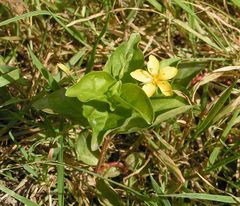Lysimachia
| Lysimachia subsp. var. | ||||||||||||||||||||||||||||||||||||||||||||||||||||||||
|---|---|---|---|---|---|---|---|---|---|---|---|---|---|---|---|---|---|---|---|---|---|---|---|---|---|---|---|---|---|---|---|---|---|---|---|---|---|---|---|---|---|---|---|---|---|---|---|---|---|---|---|---|---|---|---|---|

|
|
| ||||||||||||||||||||||||||||||||||||||||||||||||||||||
| ||||||||||||||||||||||||||||||||||||||||||||||||||||||||
Lysimachia is a genus of flowering plants. Lysimachia species often have yellow flowers, and grow vigorously. They tend to grow in damp conditions. Several species within Lysimachia are commonly called loosestrife, although this name is also used for plants within the genus Lythrum.
| Standard Cyclopedia of Horticulture |
|---|
|
Lysimachia (probably after King Lysimachus). Primulaceae. Loosestrife. Erect or creeping leafy herbs grown in damp wild gardens and borders. Leaves opposite or whorled, entire, usually black punctate: fls. spicate, racemose or solitary, with a rotate or campanulate, 5-parted corolla with an equal number of slightly monadelphous stamens opposite the lobes: caps. 1-loculed, with many seeds on a central placenta. —Over 100 species found in temperate and subtropical regions of all parts of the world. Only a few in cult., and these all perennials. They differ from related genera in the absence of staminodia between the stamens, which are usually slightly united. Revision, Knuth in Das Pflanzenreich, hft. 22, p. 256 (1905). The loosestrifes are of easy culture, thriving best in moist situations. Propagation is by division in late autumn or early spring.
|
Cultivation
Propagation
Pests and diseases
Varieties
Selected species:
- Lysimachia atropurpurea - Purple gooseneck loosetrife
- Lysimachia ciliata L. - Fringed loosestrife (North America)
- Lysimachia clethroides - Gooseneck loosestrife
- Lysimachia daphnoides (A.Gray) Hillebr. Lehua makanoe (Island of [[Kauai|KauaTemplate:Okinai]] in [[Hawaii|HawaiTemplate:Okinai]])
- Lysimachia fraseri Duby - Fraser's yellow loosestrife (Southeastern United States)
- Lysimachia filifolia C.N.Forbes (Islands of [[Oahu|OTemplate:Okinaahu]] and KauaTemplate:Okinai in HawaiTemplate:Okinai)
- Lysimachia hillebrandii Hook.f. ex A.Gray - Kolokolo kuahiwi (HawaiTemplate:Okinai)
- Lysimachia maxima (R.Knuth) H.St.John (Island of [[Molokai|MolokaTemplate:Okinai]] in HawaiTemplate:Okinai)
- Lysimachia minoricensis J.J.Rodr. (Spain)
- Lysimachia nemorum L. - Yellow pimpernel
- Lysimachia nummularia L. - Creeping Jenny, Moneywort (Europe)
- Lysimachia punctata - spotted loosestrife
- Lysimachia sertulata - Chilean melilukul
- Lysimachia quadrifolia L. - Whorled loosestrife (Eastern North America)
- Lysimachia terrestris (L.) Britton, Sterns & Poggenb. - Swamp candles (North America)
- Lysimachia thyrsiflora - tufted loosestrife
- Lysimachia verticillaris
- Lysimachia vulgaris L. - Garden loosestrife, Yellow loosestrife (Eurasia)
Gallery
-
photo 1
-
photo 2
-
photo 3
References
- Standard Cyclopedia of Horticulture, by L. H. Bailey, MacMillan Co., 1963
External links
- w:Lysimachia. Some of the material on this page may be from Wikipedia, under the Creative Commons license.
- Lysimachia QR Code (Size 50, 100, 200, 500)
